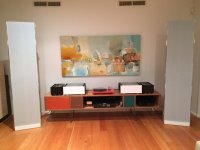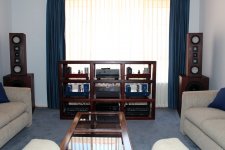Hello
Just uploaded a new document on how to upload new firmware to the board 😉
http://www.analog-precision.com/Dow...oad_firmware_to_the_Ultimate_Preamplifier.pdf
cheers
David
Just uploaded a new document on how to upload new firmware to the board 😉
http://www.analog-precision.com/Dow...oad_firmware_to_the_Ultimate_Preamplifier.pdf
cheers
David
Last edited:
Just posting a picture showing my system with the Ultimate Preamplifier in centre place.
My speakers are full range ESL Acorns from ERAudio (fantastic speakers which I have used for over 5 years now) in DIY enclosures. Each speaker has a low, mid and high panel and each has a separate transformer optimised for that panel's frequency range, and a dedicated power amplifier. The low panel uses a Hypex UcD Class D unit built into the bass of each enclosure, the mid is a DIY Pass Aleph 4, and the high is a DIY Pass Aleph J (each class A mono block visible to the side of each speaker). Sources at the moment are Roon streaming over a SOTM sms200 (with a battery power supply) through USB, a Meridian 200 CD transport via Toslink and a Rega P3 turntable - currently still playing with the latter as it has a MC cart so am using a SUT into the preamp.
My speakers are full range ESL Acorns from ERAudio (fantastic speakers which I have used for over 5 years now) in DIY enclosures. Each speaker has a low, mid and high panel and each has a separate transformer optimised for that panel's frequency range, and a dedicated power amplifier. The low panel uses a Hypex UcD Class D unit built into the bass of each enclosure, the mid is a DIY Pass Aleph 4, and the high is a DIY Pass Aleph J (each class A mono block visible to the side of each speaker). Sources at the moment are Roon streaming over a SOTM sms200 (with a battery power supply) through USB, a Meridian 200 CD transport via Toslink and a Rega P3 turntable - currently still playing with the latter as it has a MC cart so am using a SUT into the preamp.
Attachments
You can calculate this by dividing 800 MMACS by the sample rate and number of channels so the best case for the dsp alone is about 1K taps per channel at 96KHz.
cheers
Just to be clear though; this would be approx. 1000 taps per channel * 8 channels is that correct?
800 MMAC=800 million MAC/96000/8=1041 per channel.
Are they freely assignable? If so I would have thought that this would be tons.
Yes Audioweaver allows you the flexibility to assign different number of taps to each channel. You can also decimate or down sample to a lower sampling rate to multiply your tap resources. For example on the bass channels running an FIR at 192KHz is kind of a waste of DSP resources so down-sampling to say 12KHz or even 6KHz and then run your FIR at the lower sampling rates and after the FIR filter then up-sample back to 192KHz when finished.
Also the DSP hardware sampling rate can be dropped down from 192KHz to 96KHz or even 48KHz which multiplies your total tap resources by 2 and 4 respectively.
cheers
Also the DSP hardware sampling rate can be dropped down from 192KHz to 96KHz or even 48KHz which multiplies your total tap resources by 2 and 4 respectively.
cheers
Hi David
When's the next fully optioned turn keys avaiable ? I like the idea of the 4way active .
Cheers
When's the next fully optioned turn keys avaiable ? I like the idea of the 4way active .
Cheers
Will be changing the board design a little bit to make it more manufacturer friendly but all of the through hole components such as connectors etc will still be manually soldered to make sure they are perfectly aligned properly.
Will be doing a much larger run of boards this time as quite few of you have missed out unfortunately but hope to have some more stock during the first quarter of 2018.
Regards
David
Will be doing a much larger run of boards this time as quite few of you have missed out unfortunately but hope to have some more stock during the first quarter of 2018.
Regards
David
It does sound interesting linking two of these together to get more channels.
When linking them would you get a 16 channel DSP system?
What about the digital out on the PreAmp - can they be controlled by the internal volume controller?
My idea was to use this DSP PreAmp for the front 3-way speakers, and then add a cheaper crossover to one of the digital out (the two channels not used for the fronts) and use that for subwoofer control.
I guess I could use two of the analogue outputs on the PreAmp to the cheaper crossover, but I would like to avoid the extra D/A-A/D conversion to the DSP crossover for the subwoofers if possible.
When linking them would you get a 16 channel DSP system?
What about the digital out on the PreAmp - can they be controlled by the internal volume controller?
My idea was to use this DSP PreAmp for the front 3-way speakers, and then add a cheaper crossover to one of the digital out (the two channels not used for the fronts) and use that for subwoofer control.
I guess I could use two of the analogue outputs on the PreAmp to the cheaper crossover, but I would like to avoid the extra D/A-A/D conversion to the DSP crossover for the subwoofers if possible.
We can assign the S/PDIF output as another set of stereo channels for a stereo 5 way system but this would require the use of an external DAC and volume would be done by bit truncation with the possibility of some dithering. Typically this would be used for subwoofer channel with a 4-way mains.
regards
regards
Last edited:
Very happy!
I received my unit less than a week ago.
Straightforward to download the preconfigured 3-way script, adjust the lower Xover point to 100Hz (the upper one was already 1000Hz which was what I required) and save it to the on-board flash memory.
I haven't done exhaustive listening tests yet but I'm very happy after a few hours of casual listening.
I've attached a picture of the unit taking pride of place at the center of my rack.
I received my unit less than a week ago.
Straightforward to download the preconfigured 3-way script, adjust the lower Xover point to 100Hz (the upper one was already 1000Hz which was what I required) and save it to the on-board flash memory.
I haven't done exhaustive listening tests yet but I'm very happy after a few hours of casual listening.
I've attached a picture of the unit taking pride of place at the center of my rack.
Attachments
We can assign the S/PDIF output as another set of stereo channels for a stereo 5 way system but this would require the use of an external DAC and volume would be done by bit truncation with the possibility of some dithering. Typically this would be used for subwoofer channel with a 4-way mains.
regards
This would work for my setup! 😀
I could use the 4-way for the front speakers and the last 1-way S/PDIF output to another digital x-over (I currently use 4 subwoofers) with DAC's to analogue outputs.
I supose the bit truncation will not be that big of a factor for subwoofers - and I do like to have a pretty high SPL level when enjoying music.
I received my unit less than a week ago.
Straightforward to download the preconfigured 3-way script, adjust the lower Xover point to 100Hz (the upper one was already 1000Hz which was what I required) and save it to the on-board flash memory.
I haven't done exhaustive listening tests yet but I'm very happy after a few hours of casual listening.
I've attached a picture of the unit taking pride of place at the center of my rack.
Really nice setup mate.
I would say so. A friend of mine has some horribly expensive DAC (Meitner?), that costs well over $10K and he said this one sounds much better than his...
So this pre amp with features and soundquality is worth $10k?
Its not 10k, have a check of the website, its about 2.5-3k and its definitely worth it. Its way more than a pre amp.
Just posting a picture showing my system with the Ultimate Preamplifier in centre place.
My speakers are full range ESL Acorns from ERAudio (fantastic speakers which I have used for over 5 years now) in DIY enclosures. Each speaker has a low, mid and high panel and each has a separate transformer optimised for that panel's frequency range, and a dedicated power amplifier. The low panel uses a Hypex UcD Class D unit built into the bass of each enclosure, the mid is a DIY Pass Aleph 4, and the high is a DIY Pass Aleph J (each class A mono block visible to the side of each speaker). Sources at the moment are Roon streaming over a SOTM sms200 (with a battery power supply) through USB, a Meridian 200 CD transport via Toslink and a Rega P3 turntable - currently still playing with the latter as it has a MC cart so am using a SUT into the preamp.
You've had them 5 years, so did you notice much improvement when you went from 2 transformers to 3?
Yes Audioweaver allows you the flexibility to assign different number of taps to each channel. You can also decimate or down sample to a lower sampling rate to multiply your tap resources. For example on the bass channels running an FIR at 192KHz is kind of a waste of DSP resources so down-sampling to say 12KHz or even 6KHz and then run your FIR at the lower sampling rates and after the FIR filter then up-sample back to 192KHz when finished.
Also the DSP hardware sampling rate can be dropped down from 192KHz to 96KHz or even 48KHz which multiplies your total tap resources by 2 and 4 respectively.
cheers
The OpenDRC DI uses an older SHARC module I believe but offers 6144 taps per channel, albeit at 48khz, but still . . . Am I missing something ? (QUite likely)
Since I've had the Acorns I started with two transformers, all passive crossovers, driven from the Aleph 4. I then moved to bi-amped active crossovers with the Hypex module on the bass transformer and the Aleph 4 on the mid and high transformer (using a miniDSP 10x10), and then to tri-amped active adding the Aleph J on the high with it's own transformer. I think each time I have found the sound continuing to improve to my liking with each change (and now again with the ultimate pre). I have liked the process of speaker measurement to obtain plots to help tune the crossovers/Eq/gauge room effects, etc - offers maximum flexibility to tune the sound to how I like it in my listening environment.
- Home
- Vendor's Bazaar
- Hi-end DSP based multi-channel integrated Preamp/Crossover/DAC project

